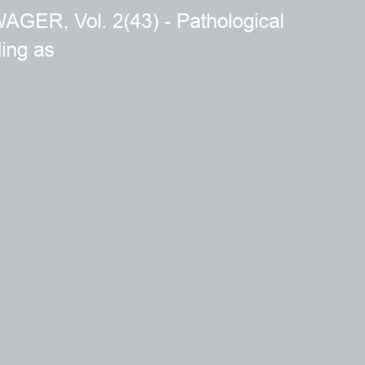The American Psychiatric Association’s Diagnostic and Statistical Manual (DSM)* classifies pathological gambling as an impulse disorder. Although clinicians often consider the DSM the “gold standard” for definitions and classifications of mental disorders and problems, it is important to understand that all disorders are a reflection of cultural norms and values. This becomes increasingly evident when comparing diagnostic manuals cross-culturally. For example, the newest edition of the Chinese Classification of Mental Disorders (CCMD-2-R)** has removed the category of pathological gambling entirely from the manual. This decision was based on the observation that pathological gambling disorder lacked contextual validity in Chinese society. Gambling that produces adverse consequences in American society may cause neither personal turmoil nor interpersonal conflict in Chinese society***. It is the cultural norms and values of a society that determine whether people consider a specific problem a crime, sin, mental disorder, or a combination of these three. Lee states that within Chinese society, “people who gamble immoderately and ruin their lives are considered bad rather than mad (p. 447)”. There are no reported cases of pathological gambling in the Chinese literature***. Many casinos interested in attracting a new clientele cater to Asians, particularly ethnic Chinese. Asian table games such as pai gow, pai gow poker, and sic bo are featured in casinos along with Asian food and casino staff who speak several Asian languages. Asian gamblers respond to these gestures by spending money (see Figure)****. These issues imply, for example, that clinicians are at risk of diagnosing a Chinese immigrant as a pathological gambler when the same individual gambled heavily in China with no personal sense of illness. These cross-cultural differences have important implications for prevention, treatment, and clinical training in cultural sensitivity. These differences also point to the importance of setting, set (psychological expectations of the gambler), and gambling activity in the development of a disorder*****.
Sources: *American Psychiatric Association. (1994). DSM-IV: Diagnostic and statistical manual of mental disorders. (Fourth ed.). Washington, D.C.: American Psychiatric Association; **Chinese Medical Association and Nanjing Medical University. (1995). Chinese classification of mental disorders, second edition, revised (CCMD-2-R). Nanjing: Dong Nan University Press; ***Lee, S. (1996). Cultures in psychatric nosology: The CCMD-2-R and international classification of mental disorders. Culture, Medicine, and Psychiatry, 20, 421-472; ****Levin, C. (1996). Cultural bull’s eye. International Gaming and Wagering Business, 17(10), p. 166-167; *****Shaffer, H.J. (1996). Understanding the means and objects of addiction: Technology, the internet, and gambling. Journal of Gambling Studies, 12 (4), 461-469.




